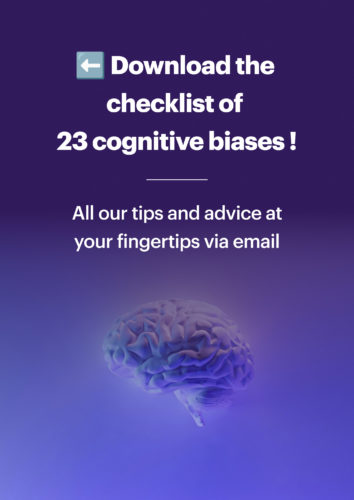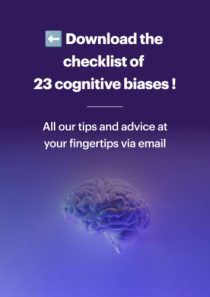In any digital project, decisions are made at every stage: whether concerning development directions, priorities, features, or even the words displayed on the screen.
These choices may seem logical, rational, or “obvious”. Yet, they are never neutral. They are always influenced, in part, by the way we perceive the world: our past experiences, our emotions, our culture, or even our role in the project.
In other words: even with the best intentions, our approach to designing a product is always filtered through invisible lenses.
Among them, a silent but very active intruder: the cognitive bias.
What is a cognitive bias?
A cognitive bias is an automatic distortion in the way we think. A mental shortcut our brain takes to act faster when faced with a decision or information. These biases are the result of evolution: they allowed us to survive in an uncertain environment by making quick decisions… but not always correct ones. For example:
- We are drawn to details that confirm our pre-existing beliefs.
- In the absence of information, our brain often fills in the gaps with stereotypes, preconceived ideas, or our own biases.
- We store memories differently depending on how we experienced them.
- To complete our tasks, we tend to focus on those in which we have already invested time and energy.
https://en.wikipedia.org/wiki/Cognitive_bias
There are over 180 documented cognitive biases to date. Not all of them directly concern design, but some are particularly common when creating a product or service.
And this is where the risk arises: these biases can influence a strategic direction, mask a real user problem, or lead us to overvalue a solution simply because we created it.
The main cognitive biases according to the project phase
Here is an overview of the most common cognitive biases according to the key phases of the design process, along with ways to avoid falling into their trap.
To learn more about the design phases, see our dedicated article: “Understanding, creating, testing: the essential role of the design phase“
1. Cognitive biases during the project definition phase
Validate the vision and objectives, understand business constraints, analyse the competition, and lay the foundations of the project.
1.1 Anchoring bias
Being overly influenced by the first idea, hypothesis, or piece of data presented.
⚠️ Consequences: The entire project is built around an initial assumption, without questioning it enough.
✅ How to avoid it:
- Never conclude a workshop with the first idea presented: always explore multiple scenarios.
- Reframe the requirements from different angles (using the “5 Whys” method, for example).
- Document decisions with multiple options evaluated, including those not chosen.
1.2 False consensus bias
Believing that others share our opinions or understanding.
⚠️ Consequences: Misinterpreting client or user expectations, lack of internal alignment.
✅ How to avoid it:
- Gather the perspectives of all stakeholders (product, tech, business, etc.).
- Use collaborative prioritisation methods (weighted voting, for example).
1.3 Dunning-Kruger effect
Overestimating one’s understanding of a subject one knows little about.
⚠️ Consequences: Rushing ahead without noticing blind spots.
✅ How to avoid it:
…
Do you want to discover all 23 cognitive biases we have listed?
They have been listed according to the project phase:
- Project Definition Phase
- User Research Phase
- Ideation Phase
- During the Definition of the User Journey
- Structure & Prioritisation Phase
- Interface Design Phase
- User Testing Phase
- Development Follow-up Phase
Download our full article in the form of a worksheet!

Why is this strategic?
Cognitive biases are natural, human, and inevitable. But in a design process, they can reduce a product’s value, distort priorities, or block innovation opportunities.
By working with a multidisciplinary team that is aware of these pitfalls, you maximise your chances of designing a product that is truly useful for your users and aligned with your business objectives.
Designing while minimising biases is possible.
Pas en les supprimant, mais en les reconnaissant, en les nommant, et en les intégrant dans une démarche méthodique.
Not by eliminating them, but by recognising them, naming them, and integrating them into a methodical approach.
Cognitive biases are neither mistakes nor faults. They are human mechanisms. What matters is the awareness we have of them and the measures we put in place to prevent them from making decisions for us.
Let’s discuss your project
Do you have a project to design or improve? Let’s talk.
At Apptitude, we test your hypotheses, encourage collaboration between areas of expertise, and bring method and perspective.





